What began in the English Channel in 1850, with the first submarine cable in the world laid by the stream tug Goliath, sparked the birth of a global market like no other.
According to Grand View Research, in 2019 the submarine-cables market was worth $21.3 billion and was expected to grow at around 7.1% from 2020 to 2027. As late as August of 2020 Technavio’s subsea cable market report (fibre) predicted a $4.34 billion growth (2020-2024), despite the impact of Covid. Even with the changes that hit the world economy, as late as November 2020 industry analysts were still predicting a 48% growth for the Europe-based submarine fibre cable market.
A voracious appetite for broadband speed is the main reason the ocean-floor market has remained so buoyant. So too is the spiralling volume of internet users. They are driving new submarine fibre cable products and infrastructure upgrades.
When the steam tug Goliath set out to sea, just short of 200 years ago, it was a revolutionary communications event, but no one imagined how the vessel’s voyage would change the way the world worked. Now oceans were no barrier to something approaching real-time communication. Then the exciting new method of communication was the telegraph. Just 16 years later the first commercially successful transatlantic submarine cable was laid between Valentia, Ireland, and Heart’s Content, Newfoundland. Submarine cable networks had made their mark on the world and the momentum would only increase.
Tratos has been manufacturing subsea cables since 1966 and is at the forefront of innovation-led subsea fibre cable technology in a market that remains dynamic and challenging. By supplying its high-quality subsea cables to the ports around the world, Tratos continuously is supporting the global endeavors of port authorities in any part of the world in upgrading and improving their operational capabilities, which further contributes to the sustainable development of ports and achieving the 17 UN Global Goals.
Tratos is following in the footsteps of some of history’s giants of innovation. It is ensuring the capacity to extend world-connectedness continues. It is advancing fibre technology – for the benefit of international trade relations – and faster ways to tackle world problems together.
From very early on this new and exciting industry was lively and vibrant, with companies merging and acquisitions abounding as stakeholders fought for the biggest share of the market.
The telephone was invented in 1876, driving a seismic communication change. Just over a decade later and the world’s first telephone submarine cable traversed the English Channel. Transatlantic radio followed.
The scale of the opportunities presented by this new and smaller world were immense. So were the challenges. Mechanical and performance challenges as well as logistics’ challenges. For cable it was challenges of pressure, one of the harshest and most corrosive of environments and, of course, the challenges of installing the cable itself.
Tratos’ Fibre Submarine Cables Today
In the time that has elapsed since the sea-bed was first explored as a conduit for global communication cable networks, the world’s most agile innovators, like Tratos, have adapted and developed submarine cable solutions for a range of other important jobs.
Carrying power for offshore wind fields for example. Submarine cables carry the highest voltages as well as the greatest number of secure telecommunication links between islands, countries and continents. Tratos manufactures power cables as well as communication cables for submarine applications, including combined power and communication cables, and of course it uses fibre-optic cables and components.
Submarine cables now carry power and links to the outside world for isolated or widely spread communities.
The manufacture, installation and operation of Submarine Cables are very different to those of land cables.
Tratos’ submarine cables are the result of the skill and expertise of seasoned engineers, most of whom have more than twenty years’ experience. The company invests constantly in the latest technology, materials and human resources needed to meet the highest performance requirements in the field. The latest generation of cables combines tried and tested manufacturing techniques with state-of-the-art technology to create cables of phenomenal strength, resilience, and flexibility.
Tratos Submarine cables are tested extensively in in-house and independent laboratory trials as well as in real-life installations. They have proven themselves exceptionally reliable.
Working with customers, Tratos can tailor-make cables to meet the demands of any application. The innovation work goes on.
Tratos’ subsea cables offer:
- HYBRID – Energy & communication, power & fibre – in one cable. Two services, one installation means cost savings and reduced operative exposure to harsh environments.
- STRENGTH – Integrity to rely on. Strength, reliability and consistency, Tratos’ cables are built to withstand the tension and torsional forces applied to them during installation and operation..
- FLEXIBILITY – When installation environments are at their harshest, a flexible, high quality, reliable, ‘right first time’ cable is the answer.
The newest hot spot for submarine cable networks is Latin America.
New projects have bloomed as data consumption, cloud, streaming, connectivity demands and digital media consumption has ramped up. In part this can be attributed to the Covid effect, as businesses have scrambled to reinvent how they do business and where they do it from.
The digital economy is not shackled by its relationship with the traditional economy. Consequently, it is well positioned to grow as its traditional forefather cools down. Good digital health is considered essential for business growth and that, in turn, has pushed demand for bandwidth expansion.
Latin America is expected to be the world’s fastest-growing region in interconnection bandwidth capacity in the next few years according to an equinix report.
Content and digital media rely heavily on international cabling, and Latin America is pushing at boundaries. So much so it is tipped to become a world capital for the highest growth rates in this, the first true digital era.
Where Next?
Since the 1990s, the submarine fibre market has been seen rapid development in optical technology, bringing efficiencies and bigger capacities. It is a sector that has had to create its own language. It is unlikely that those behind the early subsea cable-laying voyages would be able to process capacity in Megabits, let alone Terabits if they were to take a look at where what they started is now.
Cable systems can send multiple optical wavelengths over a single fibre pair. That means using less cable, and reductions in cost.
Increasing investments in offshore wind farms, more data traffic, and a rising tide of other demands are keeping submarine power cables to the fore. Today they are used for power transmission to oil rigs, carry power generated from offshore wind farms to power stations, and create inter-country and island connections.
Submarine communication cables carry around 90% of the world’s cross-continent data traffic. They are the most valued cables for some of the world’s mega companies, from Amazon to Google.
And innovation goes on. Japan’s floating wind farm, 12 miles out to sea, is likely to see 140 floating wind turbines. Manufacturers have to not only respond to needs but anticipate them and design and produce accordingly. The Europe India Gateway (EIG) submarine cable system was upgraded in early 2020 to assure connectivity for Europe, Middle East, and India’s business communities.
Tratos is honoured to be able to join the global forces toward achieving #Envision2030 Goal 14: Life Below Water’s targets:
● By 2025, prevent and significantly reduce marine pollution of all kinds, in particular from land-based activities, including marine debris and nutrient pollution.
● Minimize and address the impacts of ocean acidification, including through enhanced scientific cooperation at all levels.










